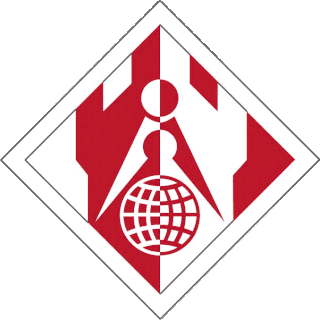
The United States Army Corps of Engineers (USACE) is an engineer formation of the United States Army that has three primary mission areas: engineer regiment, military construction, and civil works. The day-to-day activities of the three mission areas are administered by a lieutenant general known as the commanding general/chief of engineers. The chief of engineers commands the engineer regiment, composed of combat engineer army units, and answers directly to the chief of staff of the army. Combat engineers come from throughout the service and can be active duty, national guard, or army reserve. Combat engineers' duties are to construct fighting positions, fixed/floating bridges, and obstacles and defensive positions, place and detonate explosives (sappers), conduct operations that include route clearance of obstacles and rivers, prepare and install firing systems for demolition and explosives, and detect mines. For the military construction mission the commanding general is directed and supervised by the assistant secretary of the army for installations, environment, and energy, whom the President appoints and the Senate confirms. Military construction relates to construction on military bases and worldwide installations.
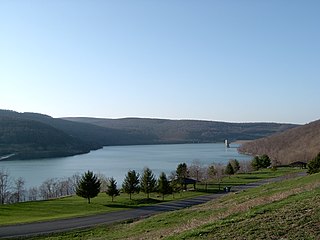
Jennings Randolph Lake is a reservoir of 952 acres (3.85 km2) located on the North Branch Potomac River in Garrett County, Maryland and Mineral County, West Virginia. It is approximately eight miles upstream of Bloomington, Maryland, and approximately five miles north of Elk Garden, West Virginia.

The Bonnet Carré Spillway is a flood control operation in the Lower Mississippi Valley. Located in St. Charles Parish, Louisiana – about 12 miles (19 km) west of New Orleans – it allows floodwaters from the Mississippi River to flow into Lake Pontchartrain and thence into the Gulf of Mexico. The spillway was constructed between 1929 and 1931 following the Great Mississippi Flood of 1927 and has been designated as a National Historic Civil Engineering Landmark by the American Society of Civil Engineers.

Gavins Point Dam is a 1.9 mi (3 km) long embankment rolled-earth and chalk-fill dam which spans the Missouri River and impounds Lewis and Clark Lake. The dam joins Cedar County, Nebraska with Yankton County, South Dakota a distance of 811.1 river miles (1,305 km) upstream of St. Louis, Missouri, where the river joins the Mississippi River. The dam and hydroelectric power plant were constructed as the Gavins Point Project from 1952 to 1957 by the United States Army Corps of Engineers as part of the Pick-Sloan Plan. The dam is located approximately 4 miles (6.4 km) west or upstream of Yankton, South Dakota.

Lewis and Clark Lake is a 31,400 acre (130 km²) reservoir located on the border of the U.S. states of Nebraska and South Dakota on the Missouri River. The lake is approximately 25 miles (40 km) in length with over 90 miles (140 km) of shoreline and a maximum water depth of 45 feet (14 m). The lake is impounded by Gavins Point Dam and is managed by the U.S. Army Corps of Engineers, Omaha District.
Design Web Format (DWF) is a file format developed by Autodesk for the efficient distribution and communication of rich design data to anyone who needs to view, review, or print design files. Because DWF files are highly compressed, they are smaller and faster to transmit than design files, without the overhead associated with complex CAD drawings. With DWF functionality, publishers of design data can limit the specific design data and plot styles to only what they want recipients to see and can publish multisheet drawing sets from multiple AutoCAD drawings in a single DWF file. They can also publish 3D models from most Autodesk design applications.
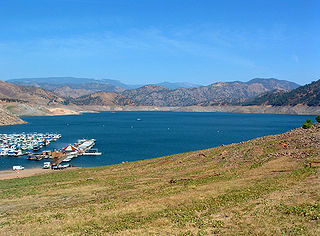
Pine Flat Lake is an artificial lake or reservoir in the Sierra Nevada foothills of eastern Fresno County, California on the western north-south border to the Sierra- and Sequoia National Forests, about 30 mi (48 km) east of Fresno. The lake is managed by the U.S. Army Corps of Engineers (USACE) and is open to boaters, campers & hikers.
Isabella Dam is an embankment dam located in the Kern River Valley, about halfway down the Kern River course, between the towns of Kernville and Lake Isabella in Kern County, California.
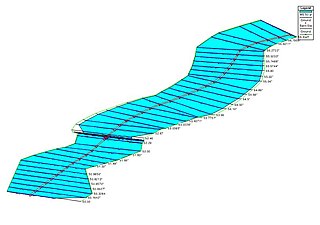
HEC-RAS is a computer program that models the hydraulics of water flow through natural rivers and other channels. Prior to the 2016 update to Version 5.0, the program was one-dimensional, meaning that there is no direct modeling of the hydraulic effect of cross section shape changes, bends, and other two- and three-dimensional aspects of flow. The release of Version 5.0 introduced two-dimensional modeling of flow as well as sediment transfer modeling capabilities. The program was developed by the United States Army Corps of Engineers in order to manage the rivers, harbors, and other public works under their jurisdiction; it has found wide acceptance by many others since its public release in 1995.
GeoPDF refers to map and imagery products created by TerraGo software applications. GeoPDF products use geospatial PDF as a container for maps, imagery, and other data used to deliver an enhanced user experience in TerraGo applications. However, GeoPDF products conform to published specifications including both the OGC best practice for PDF georegistration as well as Adobe's proposed geospatial extensions to ISO 32000, making them readable by applications such as Adobe Acrobat, Adobe Reader, Avenza PDF Maps, Global Mapper, and others. GeoPDF products often include other advanced PDF features such as layers and object data which can add significant GIS functionality to the file, particularly when used with the TerraGo Technologies plugin to Adobe Reader or other TerraGo clients.

Optima Lake was built to be a reservoir in Texas County, Oklahoma. The site is just north of Hardesty and east of Guymon in the Oklahoma Panhandle.

Terminus Dam is a dam on the Kaweah River in Tulare County, California in the United States, located near Three Rivers about 15 mi (24 km) from the western boundary of Sequoia National Park and 20 mi (32 km) east of Visalia. The dam forms Lake Kaweah for flood control and irrigation water supply. Completed by the U.S. Army Corps of Engineers (USACE) in 1962, Terminus is an earthfill dam 255 ft (78 m) high and 2,375 ft (724 m) long. The reservoir has a maximum capacity of 185,600 acre⋅ft (0.2289 km3) of water, although it usually sits at much lower levels.
SMS is a complete program for building and simulating surface water models from Aquaveo. It features 1D and 2D modeling and a unique conceptual model approach. Currently supported models include ADCIRC, CMS-FLOW2D, FESWMS, TABS, TUFLOW, BOUSS-2D, CGWAVE, STWAVE, CMS-WAVE (WABED), GENESIS, PTM, and WAM.
Mitigation banking is the preservation, enhancement, restoration or creation (PERC) of a wetland, stream, or habitat conservation area which offsets, or compensates for, expected adverse impacts to similar nearby ecosystems. The goal is to replace the exact function and value of specific habitats that would be adversely affected by a proposed activity or project. The public interest is served when enforcement agencies require more habitat as mitigation, often referred to as a mitigation ratio, than is adversely impacted by management or development of nearby acreage.
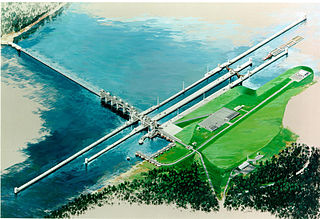
The Olmsted Locks and Dam is a locks and concrete dam on the Ohio River at river mile 964.4. The project is intended to reduce tow and barge delays by replacing the existing older, and frequently congested, locks and dams Number 52 and Number 53. The locks are located about 17 miles upstream from the confluence of the Ohio and Mississippi rivers at Olmsted, Illinois.

The Army Geospatial Center (AGC) is a Major Subordinate Command of the United States Army Corps of Engineers. It is located in Alexandria, Virginia, within the Humphreys Engineering Center adjacent to the Fort Belvoir military reservation.

Willow Creek Dam is a dam in Morrow County of the U.S. state of Oregon, located just east of Heppner's city limits. It was the first major dam in the United States constructed of roller-compacted concrete.

Success Dam is a dam across the Tule River in Tulare County, California in the United States. Serving mainly for flood control and irrigation, the dam is an earthen embankment structure 156 feet (48 m) high and 3,490 feet (1,060 m) long. The dam lies about 5 miles (8.0 km) east of Porterville and impounds Lake Success, which has a capacity of 82,300 acre-feet (0.1015 km3).
Construction Operations Building Information Exchange (COBie) is an international standard relating to managed asset information including space and equipment. It is closely associated with building information modeling (BIM) approaches to design, construction, and management of built assets.

West Point Lake is a man-made reservoir located mostly in west-central Georgia on the Chattahoochee River and maintained by the U.S. Army Corps of Engineers (USACE). The Chattahoochee river flows in from the north, before flowing through the West Point Dam, which impounds the lake, and continuing to Columbus, Georgia. Of the four major USACE lakes in the ACF River Basin, West Point Lake is the smallest by area containing 25,864 acres (10,467 ha) of water, and has the second shortest shoreline at 604 mi (972 km). The purposes of the reservoir are to provide flood control, hydroelectric power, and water storage to aid the navigation of the lower Chattahoochee.













